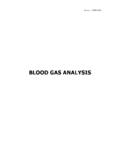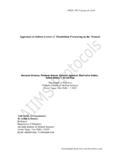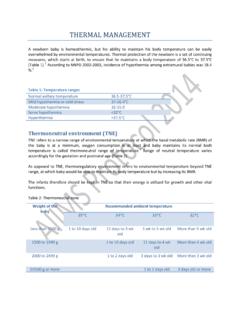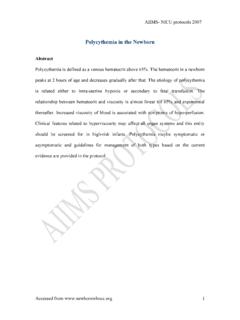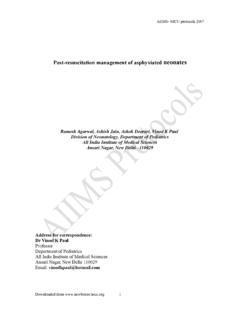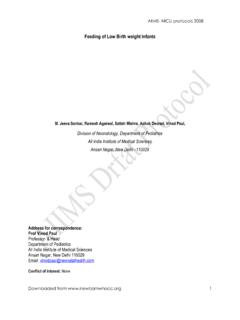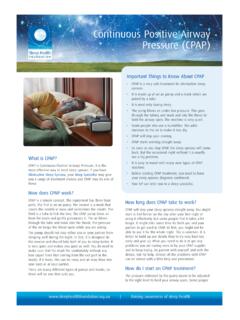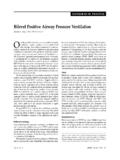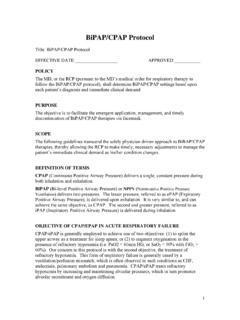Transcription of Apnea in the Newborn
1 Apnea in the NewbornRajiv Aggarwal, Ashwini Singhal, Ashok K Deorari, Vinod K PaulDivision of Neonatology, Department of PediatricsAll India Institute of Medical SciencesAnsari Nagar, New Delhi 110029 Address for correspondence:Dr Vinod K PaulAdditional ProfessorDepartment of PediatricsAll India Institute of Medical SciencesAnsari Nagar, New Delhi 110029 Email: defined as cessation of breathing resulting in pathological changes in heart rate and oxygen saturation, is a common occurrence in sick neonates. Apnea is a common manifestation of various etiologies in sick neonates.
2 In preterm children it may be related to the immaturity of the central nervous system. Secondary causes of Apnea should be excluded before a diagnosis of Apnea of prematurity is made. Methylxanthines and Continuous Positive Airway Pressure form the mainstay of treatment of Apnea in neonates. Mechanical ventilation is reserved for Apnea resistant to above therapy. An approach to the management of Apnea in neonates has been in the Newborn1. IntroductionAbout 30-45% of preterm babies exhibit a periodic breathing pattern characterized by 3 or more respiratory pauses of greater than 3 seconds duration with less than 20 seconds respiration between pauses.
3 Periodic breathing is a normal event, is usually not associated with any physiological changes in the infant and does not merit any treatment. Apnea is a pathological cessation of breathing that results in physiological changes (decrease in central drive, peripheral perfusion, cyanosis, bradycardia, hypotonia) and merits treatment. 2. DefinitionApnea is defined as cessation of respiration for >20 sec or cessation of respiration of any duration accompanied by bradycardia (HR <100/min) and/or Incidence Apnea in preterms is usually related to immaturity of the central nervous system and is called Apnea of Prematurity (AOP).
4 It may be secondary to other causes and is a common manifestation of most neonatal diseases. AOP is related inversely to gestational age with 25% of preterm below 34 weeks needing either pharmacological or ventilatory support for repeated apneic episodes. 34. Causes of Apnea of prematurity: It is probably related to immaturity of the central nervous system. This condition usually presents after 1-2 days of life and within the first 7 days. Apnea presenting within the first 24 hours or after 7 days of age is unlikely to be AOP. Secondary causes: Secondary causes of Apnea include: (a) Temperature problems: Hypothermia and hyperthermia, (b) Neurological: Birth trauma, drugs, intracranial infections, intracranial hemorrhage, perinatal asphyxia, anesthetic drugs (c) Pulmonary: Respiratory distress syndrome (RDS), pneumonia, chronic lung disease, pulmonary hemorrhage, obstructive airway lesion, pneumothorax.
5 (d) Cardiac: Congenital cyanotic heart disease, hypo/hypertension, congestive heart failure, patent ductus arteriosus (e) Gastro-intestinal: Gastro esophageal reflux, esophagitis (f) Hematological: Anemia, polycythemia (g) Infections: Sepsis, necrotizing enterocolitis (h) Metabolic: Hypoglycemia, hypocalcemia, hyponatremia, hypernatremia and (i) Inborn errors of metabolismApnea of prematurity is a diagnosis of exclusion and should be considered only after secondary causes of Apnea have been excluded. Common causes of secondary Apnea include sepsis, pneumonia, asphyxia, temperature instability and anemia.
6 5. Types of Central Apnea : (40%) Both the inspiratory effort and airflow cease simultaneously in this type of Apnea (Absence of chest wall movement and airflow). Obstructive Apnea : (10%) This type is characterized by absence of airflow in the presence of inspiratory efforts (Presence of chest wall movement but no airflow). Mixed Apnea : (50%) Central Apnea is either preceded or followed by airway obstruction. 6. MonitoringAll babies less than 34 weeks gestation should be monitored for at least the first week of life or till absence of apneic episodes for at least 7 days.
7 Babies 34 weeks gestation should be monitored if they are sick 7. Apnea Movement sensors: (Ripple type mattress) These monitors interpret chest/ abdominal movements as respiration. In general, these monitors will fail to diagnose obstructive Apnea and may not distinguish body movements from Thoracic impedence based monitors: These monitors translate changes in thoracic impedence that occur with breathing, as respiratory activity. These monitors will also fail to diagnose obstructive Pulse oximeters: These are commonly used for monitoring of Apnea . These monitors detect changes in heart rate and/ or saturation due to apneic episodes.
8 Facility for detecting chest wall movement is absent in these monitors. Apnea monitors based on chest wall movement are likely to miss obstructive Apnea . Monitors with facilities for measuring heart rate and oxygen saturation would be useful in the monitoring of significant Apnea in preterm infants. 58. Differential Periodic breathing: It consists of breathing for 10-15 seconds, followed by Apnea for 5-10 sec without change of heart rate or color. It does not occur within the first 2 days of Subtle seizures: Apnea is an uncommon presentation of a neonatal seizure.
9 Sudden alteration in muscle tone, twitching movements, vacant stare and up rolling of eyes suggests a seizure. Also tachycardia preceding/ accompanying an apneic attack usually suggests seizure Evaluation of a child with Emergency treatment The neonate should be checked for bradycardia, cyanosis and airway obstruction. The neck should be positioned in slight extension; oro-pharynx gently suctioned and tactile stimulation should be given. Most apneic spells respond to tactile stimulation. Provide oxygen if patient is hypoxic (maintain saturation 92-95%) by head box or nasal cannula.
10 If the Newborn continues to remain apneic and does not respond to tactile stimulation, ventilation with bag and mask (BMV) using 100% oxygen should be initiated. If BMV fails to initiate spontaneous respiration in the Newborn , then the infant should be managed with positive pressure ventilation. Clinical examinationAfter stabilization, the infant should be evaluated for a possible underlying cause. History should be reviewed for possible causes of secondary Apnea including perinatal asphyxia, maternal drugs, features of neonatal sepsis and feeding intolerance.
